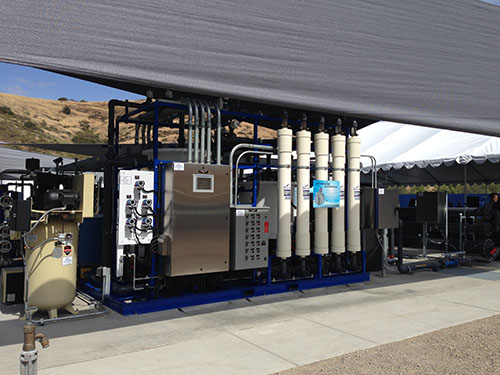 The Padre Dam Municipal Water District’s Ray Stoyer Water Recycling Facility currently converts wastewater generated within the district’s service area into recycled water. The proposed expansion project would expand the capacity of the Ray Stoyer Water Recycling Facility from 2.0 million gallons per day (MGD) to 6.0 MGD. The capacity would be increased by installing additional conventional treatment facilities, converting biological basins to nitrogen removal only, and installing a 2.2 MGD (annual average) Advanced Water Treatment Plant (AWTP). The AWTP would enable the district to send highly treated recycled water (using micro-filtration, reverse osmosis, and advanced oxidation) to a groundwater recharge and reclamation project (GRRP) for injection into the Santee Basin aquifer or to surface discharge at Lake Jennings, increasing water supply reliability in the area.
The Padre Dam Municipal Water District’s Ray Stoyer Water Recycling Facility currently converts wastewater generated within the district’s service area into recycled water. The proposed expansion project would expand the capacity of the Ray Stoyer Water Recycling Facility from 2.0 million gallons per day (MGD) to 6.0 MGD. The capacity would be increased by installing additional conventional treatment facilities, converting biological basins to nitrogen removal only, and installing a 2.2 MGD (annual average) Advanced Water Treatment Plant (AWTP). The AWTP would enable the district to send highly treated recycled water (using micro-filtration, reverse osmosis, and advanced oxidation) to a groundwater recharge and reclamation project (GRRP) for injection into the Santee Basin aquifer or to surface discharge at Lake Jennings, increasing water supply reliability in the area.
The District is seeking financing from the Water Quality, Supply, and Infrastructure Improvement Act (passed by Proposition 1 in November 2014) as well as the State Water Resources Control Board (SWRCB) Clean Water State Revolving Fund (SRF) Program for the project. Because the SRF Facility Program is partially funded by the U.S. Environmental Protection Agency (USEPA), the project requires compliance not only with the California Environmental Quality Act (CEQA), but also with federal regulations such as the Clean Air Act (CAA), Endangered Species Act (ESA), and National Historic Preservation Act (NHPA) Section 106 as part of the SWRCB’s CEQA-Plus requirements. HELIX Environmental Planning (HELIX) prepared the air quality/greenhouse gas, biological resources, and cultural resources technical reports; IS/MND; and CEQA-Plus package. HELIX conducted Native American outreach per the requirements of Section 106 and the CEQA-Plus process.
